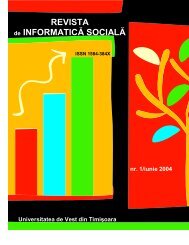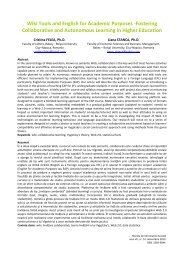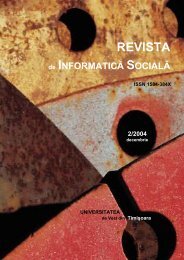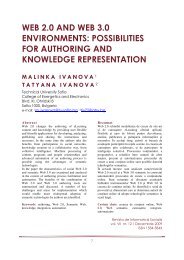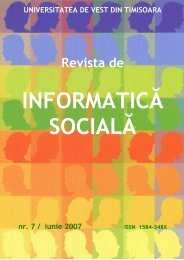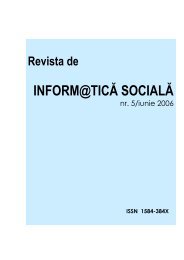No 14 - Journal of Social Informatics / Revista de Informatica Sociala
No 14 - Journal of Social Informatics / Revista de Informatica Sociala
No 14 - Journal of Social Informatics / Revista de Informatica Sociala
You also want an ePaper? Increase the reach of your titles
YUMPU automatically turns print PDFs into web optimized ePapers that Google loves.
Open University now has a lea<strong>de</strong>r from industry with fresh i<strong>de</strong>as, and seems to be working hard torefresh its mo<strong>de</strong>l and lead the UK again: to re-invent its mix <strong>of</strong> practices to fit today’scircumstances and to move to Stages III-V. Other non-pr<strong>of</strong>its like Regis University have emulatedthese methods. There may be as many as a million learners involved in these kinds <strong>of</strong> learningexperiences in the U.S.These institutions focus on consistent, <strong>de</strong>monstrable outcomes and learning experiences especiallyattuned to the needs <strong>of</strong> working adult learners. The for-pr<strong>of</strong>its have achieved substantially lowerproduction/<strong>de</strong>livery costs per stu<strong>de</strong>nt than traditional universities. This means paying close attentionto class size: bigger means more opportunity to achieve economies <strong>of</strong> scale, without sacrificingquality <strong>of</strong> engagement and outcomes. Course materials are created by teams and used in allinstances <strong>of</strong> the course. The for-pr<strong>of</strong>its utilize a core, standardized curricula to ensure consistencyand quality <strong>of</strong> learning outcomes that, in turn, allows for continuous improvements, refinements andability to quickly incorporate new industry competencies. This practice affords economies <strong>of</strong> scope.At the same time, these institutions are able to charge a premium price for their <strong>of</strong>ferings because <strong>of</strong>the recognized value they provi<strong>de</strong> learners (courses taken sequentially with no <strong>de</strong>lay, acceleratedtime to <strong>de</strong>gree, lack <strong>of</strong> family/work barriers and premium online services). Even within the marketdrivencluster (as some <strong>of</strong> these institutions prefer to be called), however, there is variation in therelative price point.The higher resulting margin/pr<strong>of</strong>it (difference between price and actual cost) is invested inextending institutional brand, business/industry market research and instructional technology andsystems <strong>de</strong>velopment costs. Most <strong>of</strong> the for-pr<strong>of</strong>it institutions spend between 25-30 percent <strong>of</strong> theirbudget on marketing (extending the institutional brand).In future stages <strong>of</strong> <strong>de</strong>velopment, many <strong>of</strong> today’s for-pr<strong>of</strong>it provi<strong>de</strong>rs may not be able to maintaintheir current premium price levels, in the face <strong>of</strong> competition now emerging at the low end (fromno-fee systems) and at the high end (from innovators such as Capella University who have migratedto a more competence-based approach that achieves a higher perceived value with learners).Moreover, Capella-type innovators will be able to compete on lowering the total cost <strong>of</strong> achievinglearning and competence objectives and eventually become certifying enterprises. More discussionabout that is in the <strong>de</strong>scription <strong>of</strong> Stages IV and V.These innovators have also succee<strong>de</strong>d in embedding predictive analytics into their aca<strong>de</strong>mic andadministrative processes, and use those tools to support stu<strong>de</strong>nt success, in a manner that makestraditional institutional practice seem primitive.Summary <strong>of</strong> Stage II: First Generation Unbundled LearningCharacteristics: Unbundled learning, assessment and certification; team-based course<strong>de</strong>velopment, faculty as mentors.Transformative Impact: Transformed roles, responsibilities, reinvented and sustainablefinancial mo<strong>de</strong>l.Impacts on Institutional/Stu<strong>de</strong>nt Costs:These institutions are able to operate at lower costs, but can charge a premium price because <strong>of</strong>the value perceived by stu<strong>de</strong>nts. They spend 25-30% on marketing and invest in online supportand analytics.Exemplary Institutions/Participants: The Open University (UK) – pioneer in unbundling University <strong>of</strong> Phoenix, Capella University, Kaplan, American Public University System,Regis University (NFP), others – pushing the envelope <strong>of</strong> the market-driven mo<strong>de</strong>l Embed<strong>de</strong>d analytics improve success and performance – mo<strong>de</strong>ls for higher education inthe future.




